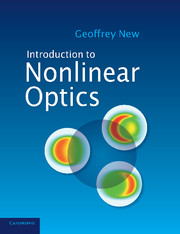Book contents
- Frontmatter
- Contents
- Preface
- Acknowledgements
- 1 Introduction
- 2 Frequency mixing
- 3 Crystal optics
- 4 Nonlinear optics in crystals
- 5 Third-order nonlinear processes
- 6 Dispersion and optical pulses
- 7 Nonlinear optics with pulses
- 8 Some quantum mechanics
- 9 Resonant effects
- 10 High harmonic generation
- Appendix A Conventions and units
- Appendix B Linear and nonlinear susceptibilities in the time and frequency domains
- Appendix C Definition of the nonlinear coefficients
- Appendix D Non-zero d elements in non-centrosymmetric crystals
- Appendix E Real fields, complex fields, and the analytic signal
- Appendix F Geometry of the grating pair
- Appendix G The paraxial wave equation
- Appendix H Useful formulae for numerical simulations
- Appendix I Useful constants
- Answers to problems
- Further Reading
- References
- Index
4 - Nonlinear optics in crystals
Published online by Cambridge University Press: 05 June 2012
- Frontmatter
- Contents
- Preface
- Acknowledgements
- 1 Introduction
- 2 Frequency mixing
- 3 Crystal optics
- 4 Nonlinear optics in crystals
- 5 Third-order nonlinear processes
- 6 Dispersion and optical pulses
- 7 Nonlinear optics with pulses
- 8 Some quantum mechanics
- 9 Resonant effects
- 10 High harmonic generation
- Appendix A Conventions and units
- Appendix B Linear and nonlinear susceptibilities in the time and frequency domains
- Appendix C Definition of the nonlinear coefficients
- Appendix D Non-zero d elements in non-centrosymmetric crystals
- Appendix E Real fields, complex fields, and the analytic signal
- Appendix F Geometry of the grating pair
- Appendix G The paraxial wave equation
- Appendix H Useful formulae for numerical simulations
- Appendix I Useful constants
- Answers to problems
- Further Reading
- References
- Index
Summary
Introduction and preview
As noted in Section 1.8, the treatment presented in Chapter 1 was greatly over-simplified. The fact that the frequency dependence of the coefficients in the polarisation expansion was neglected gave the false impression that the coefficients governing all processes of a given order are the same, apart from simple factors. The tensor nature of the coefficients was completely ignored too.
Unfortunately, if one wants to understand nonlinear optical interactions in crystalline media, one cannot avoid getting to grips with the tensor nature of the nonlinear coefficients, a topic that is intricate and hard to simplify. At the very least, one needs to be able to interpret the numerical notation used to label the coefficients, and to know how to apply the data supplied in standard reference works in a given crystal geometry.
There is no disguising the fact that Section 4.3 in the present chapter is rather complicated. Readers who want to avoid the worst of the difficulties should skim it, always bearing in mind that the situation turns out to be far less alarming at the end of the journey than it seemed it might be at the beginning. Early on in that section, it looks as if there could be literally hundreds of separate nonlinear coefficients to deal with. But it soon emerges that the number is almost certainly no larger than 18, and perhaps only 10.
- Type
- Chapter
- Information
- Introduction to Nonlinear Optics , pp. 62 - 75Publisher: Cambridge University PressPrint publication year: 2011

